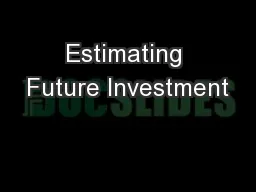

Earnings Today Martin Cassell CFA CEO amp CIO Questions to Address How can future investment earnings be estimated Why does the earnings rate matter Does history matter How can rolling time periods help manage results ID: 549068
Download Presentation The PPT/PDF document "Estimating Future Investment" is the property of its rightful owner. Permission is granted to download and print the materials on this web site for personal, non-commercial use only, and to display it on your personal computer provided you do not modify the materials and that you retain all copyright notices contained in the materials. By downloading content from our website, you accept the terms of this agreement.
Slide1
Estimating Future Investment
Earnings Today
Martin Cassell, CFA
CEO & CIOSlide2
Questions to AddressHow can future investment earnings be estimated?Why does the earnings rate matter?
Does history matter?How can rolling time periods help manage results?Is there a disclosure statement?Of course, please see the statement at the end of this presentation for important disclosure information2Slide3
Forecasting EarningsKey components affecting an earnings forecastForecast period.Investment portfolio balance.
Purchase yield of investment portfolio.Investments maturing.Reinvestment rate of cashflows.3Slide4
Possible Forecasting InputsPurchase Yield to MaturityMarket Yield to Maturity
Historical ReturnsMarket Benchmark ReturnInflation RateImplied Forward Rates4Slide5
Investment BalanceInvestment BalanceEstablish the beginning investment balanceMarket value
Book valueAccrued InterestInclude any potential contribution/withdrawals5Slide6
Current Portfolio IncomeIncome from existing securitiesSum the securities maturing during the forecast period.Calculate the weighted average purchase yield of the current portfolio.
Purchase Yield = Yield to Maturity at time of purchaseMultiply the securities remaining in the portfolio by the weighted average purchase yield to calculate the income forecast.6Slide7
Forward Rates7
Source: Bloomberg, LLPSlide8
Reinvestment IncomeIncome from reinvestment of maturitiesCalculate the average number of days until reinvestment of the maturity of securities.Forecast a reinvestment rate for security maturities
Gov’t forward ratesCorporate forward ratesBlended forward ratesMultiply the dollar amount of the maturing securities by the reinvestment rate.Multiple the above value by the fraction time period of the left on the horizon period.8Slide9
Total Portfolio IncomeTotal Portfolio IncomeAdd existing portfolio income to the reinvestment income to calculate the total portfolio income forecast.
9Slide10
Interest Earnings Forecast10Slide11
The Earnings Rate MattersThe earnings rate helps to estimate the growth of the portfolioThe growth of the portfolio helps to pay for future liabilities
Underestimating the earnings rate can create a funding shortfallWhat is the appropriate time period for earnings?Does history have a roll in forecasting future earnings?11Slide12
Developing A Rolling Return Estimate12
Incorporating historical return information and future earnings estimate Seeking an effective estimate of future returnsSlide13
Required Future Return13
For a given discount rate, what do we need to earn in the future?What rate of return do we need to earn for a given discount rate?Slide14
Finding an Reasonable Discount Rate14
The 3 year historical return and the 2 year future return estimate have an expected return of about 3%Slide15
Rolling Return Estimates15
A combination of historical returns and estimated future earnings may help provide a relatively stable and effective tool to help a pool manage funding of future liabilities.Slide16
ConclusionsForecasting is an estimate, not an absoluteKnown facts can help improve your forecast - better than a SWAG
It is always prudent to be conservative in your forecastPast performance does not guarantee future results16Slide17
The Future is Clear17Slide18
Biographies18
Martin Cassell, CFACEO, Chief Investment OfficerMartin Cassell is the chief executive and investment officer at Chandler Asset Management and is a principal of the firm. Mr. Cassell is responsible for defining, planning, and directing company programs. He heads implementation of the firm’s investment strategies and portfolio risk management. He designed the proprietary quantitative models that drive our investment process, establishing duration, structure, and asset allocation throughout client portfolios. Mr. Cassell joined Chandler Asset Management in 1991 from the City of San Diego where he managed a $1 billion fixed income portfolio. He began his investment career in 1987 managing portfolios at World Savings and Loan. Mr. Cassell received his B.S. in finance from California State University, Hayward. He is a member of the CFA Society of San Diego and holds the designation of Chartered Financial Analyst. He is also a member of the California Association of Joint Power Authorities (CAJPA) finance committee.
Jayson Schmitt, CFASenior Vice President, Portfolio ManagerJayson Schmitt is a senior vice president and portfolio manager at Chandler Asset Management. He has been instrumental in the development and integration of quantitative analytic tools for the portfolio management process. Prior to joining Chandler Asset Management in 1995, Mr. Schmitt was employed as a financial analyst with USA Federal Credit Union in San Diego, managing a $100 million liquidity book. His responsibilities there also included asset/liability management. Mr. Schmitt earned his B.A. in economics from San Diego State University. He is a member of the CFA Society of San Diego and holds the designation of Chartered Financial Analyst.Slide19
DisclosuresDISCLOSURESPast performance is not indicative of future results, which may vary. There is no guarantee that any opinion, forecast, or objective will be achieved. The information herein is provided for informational purposes only and should not be construed as a recommendation of any security, strategy or investment product, nor as an offer or solicitation for the purchase or sale of any financial instrument. The financial model described in this presentation has been prepared using a hypothetical portfolio and assumptions provided by the author for the purposes of demonstrating the model. References to specific securities, issuers and market sectors are for solely illustrative purposes of the model presented herein.
This presentation contains the current opinions of the author, which are subject to change without notice. Any statements concerning financial market trends are based on current market conditions, which will fluctuate. Forecasts and assumptions are inherently limited and should not be relied upon as an indicator of future results. Unless otherwise noted, Chandler is the source of the tables, graphs, performance data and characteristics contained in this presentation.19